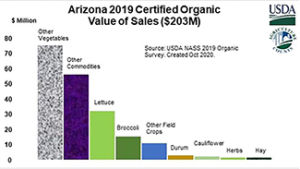Just the Facts About Organics
2021 marks the 20th anniversary of the U.S. Department of Agriculture starting to implement its organic food rules. For those that go through the certification process, the USDA organic food rules allow companies to feature a “USDA Organic” seal on their packaging. This seal of approval has helped the U.S. organic food market expand from less than $8 billion in sales in 2000 to more than $50 billion in 2019.
- The “organic” designation scope: The goal of the designation was simply to fortify trust in the fast-growing but fragmented organic food market. “Let me be clear about one thing,” said Dan Glickman, the Clinton Administration’s Secretary of Agriculture who oversaw the organics designation. “It is not a statement about food safety. Nor is ‘organic’ a value judgment about nutrition or quality.”
Organic Farming in Arizona
 Arizona’s value of sales of certified organic commodities in 2019 (most recent figures available) totaled $203 million, compared to $118M in 2016.
Arizona’s value of sales of certified organic commodities in 2019 (most recent figures available) totaled $203 million, compared to $118M in 2016.- Vegetable sales accounted for 64% of these sales compared to 68% in 2016.
Regarding Chemicals
- The key determinant of whether something qualifies as organic involves something rather mundane: the production method.
- For crops, the origin of the seed, for example, if important— it must be organically grown and cannot be the product of genetic engineering (e.g. GMOs or gene editing).
- Most assume organic food is grown without chemicals – and seemingly-credible outlets contribute to this impression.
- All farmers – both organic and conventional – use both chemical and non-chemical pest management (or containment) methods.
- More than 100 fertilizers and inputs (pesticides, insecticides or fungicides) are authorized by organic farming regulations in both Europe and the United States.
- Organic regulations were designed to promote the use of natural chemical over synthetic ones. But many natural chemicals do not work well controlling pests often resulting in more applications during the growing process.
- Even though the absence of synthetic pesticides is often cited in support of organics, the reality is that organic farmers have gotten approval from USDA to use dozens of synthetic chemicals, from vaccines for animals to pheromones to confuse insects.
- Also permitted are non-synthetic pesticides, which can be less effective than synthetic pesticides and thus need to be deployed at a higher level than in non-organic farming.
- All pesticides — synthetic or not — must meet identical safety standards and are regulated by USDA and EPA.
- When used according to the label, approved chemicals, synthetic or natural, do not pose meaningful health risks.
- The conclusion of food scientists at the University of California-Davis: “The marginal benefits of reducing human exposure to pesticides in the diet through increased consumption of organic produce appear to be insignificant.”
Organics and Health
- Are organics inherently healthier? One obvious answer to this idea is the existence of many products with no redeeming health qualities that have nonetheless secured the USDA’s organic certification. This includes potato chips, ice cream sandwiches, and even some cigarettes. As is often pointed out, organic junk food is still junk food.
- There’s also rigorous research that calls into question the superior health benefits of organic food. Researchers at Stanford University sifted through 237 research papers and found little evidence that organic foods are healthier than conventional alternatives. “Some believe that organic food is always healthier and more nutritious. We were a little surprised that we didn’t find that,” said Crystal Smith-Spangler, a Stanford Medicine instructor and one of the paper’s authors.
- The Stanford findings echoed another review of 137 studies published in the American Journal of Clinical Nutrition in 2009 and commissioned by the UK Food Standards Agency.
- These studies comport with what many other experts have said. Organic and conventionally grown foods are “really similar for vitamins, minerals, and carbohydrates,” notes the head of nutrition at the Harvard-affiliated Brigham and Women’s Hospital.
- Even a news site devoted to touting organic food acknowledges that there is “not nearly enough [evidence] to make categorical claims” about organic food being “nutritionally superior” to non-organic food.
- There’s no certification process for restaurants’ use of “organic” and investigations have turned up examples of self-proclaimed “organic” restaurants serving food that doesn’t comply with the federal rules.
- The “organic” label on cigarettes has been found to reduce perceptions of their ill effects. Similarly, a study by two University of Michigan professors found that some people believed that consuming organic food made exercise less important.
Organics and the Environment
Crop Yields: As farming and technology have evolved, we now grow more food on less land. That’s a win for the environment. But because the rules governing organic farming prevent the usage of some modern practices, organic crops don’t grow as efficiently and require more farmland for a given amount of food produced. The reduced yield can be as much as 34% less than for conventional farming, according to a study published in Nature.
- Crop biologist Steve Savage looked at the impact of shifting all U.S. agricultural output to organic. The analysis, published by the Genetic Literacy Project, found that compensating for organics’ lower efficiency would require the cultivation of more than 100 million additional acres — a land mass larger than the entire state of California.
- Savage points out that “organic farming is not the best way to farm from an environmental point of view. [T]here are now several cutting-edge agricultural practices which are good for the environment, but difficult or impossible for organic farmers to implement within the constraints of their pre-scientific rules.”
Climate Change?
- A recent study in Sustainability, a peer reviewed journal, called out organics for their lack of innovation related to climate change impact, citing higher greenhouse gas emissions from increased acreage, as well as organic food companies resisting the adoption of emerging technologies that could curtail harmful emissions.
- A 2019 Nature study assessed the potential impact on Wales if it met the Farm-2-Fork Green Deal objectives. The study found that it would mean a 40% yield drag and an increase in greenhouse gas emissions by as much as 58%, since more land would need to be tilled to compensate for the production shortfall. Rather than growing enough to feed their own population, European countries would need to begin importing food. The need for imports would mean increased food production in other countries – an outcome that would likely result in clear-cutting of tropical forests throughout the world, according to the authors of a this column in Nature published last year.
Anti-technology bias
- Fears about the safety of genetically modified organisms: They cannot be included in organic food, which suggests there must be something unsafe about them. Yet more than 90 percent of U.S. corn, cotton, and soybeans are genetically modified. More than half of GMOs are now grown in the developing world. No reliable study has ever shown any risks from eating GMO food, which have been sold in the United States since 1994. More than 150 Nobel laureates have attested to the safety of GMO foods.
- Genetic engineering helps protect the environment. Gene editing tools such as CRISPR can strengthen pest resistance, increase crop yields, and reduce emissions connected to farming.
- Genetically modified crops are the key to promoting agricultural sustainability. Critics of GMO foods ignore that genetically engineered variants have saved entire food categories in Hawaii (papayas), Bangladesh (eggplants), and many other crops that require disease and pest resistance. A new potato bred for African farming, eliminates the need for fungicides that are otherwise required to resist a blight that can destroy up to 60 percent of the potato crop in a country such as Uganda. Efforts to undermine the value of such high-yielding, disease-resistant genetically engineered foods stand in the way of progress and prosperity for African and Asian farmers.
- One conclusion on organics of one of the world’s leading agronomists, Louise Fresco, a Dutch sustainable food scientist: “Organic farming as a whole is a mish-mash of valuable goals and ideals that have either been insufficiently tested or are completely misguided.”
Why Organics has Value
- For one, the Market asks for it.
- Farmers and ranchers grow and raise what the market demands.
- It’s common for small, organic growers to producer a wider array of fruits and vegetables since they are catering to a consumer with a variety of interests and tastes, often high-end chefs and the high-end, home-based chef.
Outdoor Living | #OrganicVSTraditionalFarming
###
Podcast
The Arizona Farm Bureau’s Julie Murphree is joined by John Boeltz of Desert Premium Farms in Yuma. For the 20th Anniversary of the USDA’s Organic Certification Rules, we discuss the standards farmers need to grow organic produce. What John is growing year round on his farms. The differences between organic and traditional farming. And explaining why organic ‘is not a statement about food safety, nor is organic a value judgement about nutrition or quality’ (Dan Glickman)
Photo Credit
- USDA
Related Content
- DIY FAQ: Four Tips To Consider When Buying Local Beef
- DIY FAQ: What are the 5 C’s of Arizona
- DIY FAQ: Arizona Farm Fresh Lettuce
















